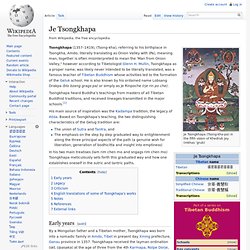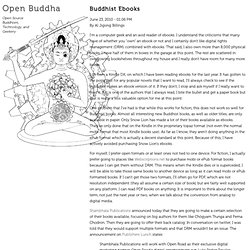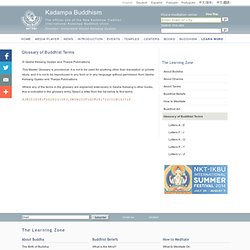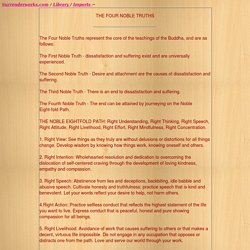

Internet Sacred Text Archive Home. Tsongkhapa Lobzang Drakpa. Je Tsongkhapa. Je Tsongkhapa (Tsong-kha-pa) in the fifth vision of Khedrub Jey (mkhas ’grub) Tsongkhapa (1357–1419), (Tsong-kha), referring to his birthplace in Tsongkha, Amdo; literally translating as Onion Valley with (Pa), meaning man, together is often misinterpreted to mean the 'Man from Onion Valley," however according to Tibetologist Glenn H.

Mullin, Tsongkhapa as a proper name, was likely never intended to be literally translated, was a famous teacher of Tibetan Buddhism whose activities led to the formation of the Geluk school. He is also known by his ordained name Lobsang Drakpa (blo bzang grags pa) or simply as Je Rinpoche (rje rin po che). Tsongkhapa heard Buddha’s teachings from masters of all Tibetan Buddhist traditions, and received lineages transmitted in the major schools.[1] His main source of inspiration was the Kadampa tradition, the legacy of Atiśa. Early years[edit] Daily Lamrim. Assorted Teachings. Buddhist Ebooks. I'm a computer geek and an avid reader of ebooks.

I understand the criticisms that many have of whether you "own" an ebook or not and I certainly don't like digital rights management (DRM) combined with ebooks. That said, I also own more than 8,000 physical books. I have half of them in boxes in the garage at this point. The rest are scattered in overflowing bookshelves throughout my house and I really don't have room for many more books. I do own a Kindle DX, on which I have been reading ebooks for the last year. One problem that I've had is that while this works for fiction, this does not work so well for Buddhist books. For myself, I prefer open formats or at least ones not tied to one device.
Shambhala Publications announced today that they are going to make a certain selection of their books available, focusing on big authors for them like Chögyam Trunga and Pema Chodron. Shambhala Publications will work with Open Road as their exclusive digital marketing partner. The Berzin Archives – The Buddhist Archives of Dr. Alexander Berzin – Home Page. NEW: All about ROSARIES (mala) - Tsem Tulku Rinpoche. NKT - Buddhist Practices. Happiness is a state of mind, therefore the real source of happiness lies in the mind, not in external circumstances.

If our mind is pure and peaceful we shall be happy, regardless of our external conditions, but if it is impure and unpeaceful we shall never find happiness, no matter how much we try to change our external circumstances. Meditation enables us to cultivate those states of mind that are conducive to peace and well-being, and eradicate those that are not. To meditate successfully we first need to listen to authentic teachings from a qualified Meditation Teacher and study qualified meditation books.
Through study and meditation we develop three types of wisdom: Wisdom arisen from listeningWisdom arisen from contemplatingWisdom arisen from meditation When fully developed, these wisdoms completely eradicate all negativity and all confusion from the mind. This section is designed to introduce such practices. and to give you a taste of the beneficial experiences they lead to. NKT - The Foundation Program (FP) Guided Meditations. NKT - Glossary of Buddhist Terms.
© Geshe Kelsang Gyatso and Tharpa Publications This Master Glossary is provisional.

It is not to be used for anything other than translation or private study, and it is not to be reproduced in any form or in any language without permission from Geshe Kelsang Gyatso and Tharpa Publications. Buddhist Audio Teachings. LamRim.com - Tibetan Buddhist Internet Radio. Om Mani Padme Hum: The Meaning of the Mantra in Tibetan Buddhism. Glimpsing a Few More Facets of the Mantra There are many ways to understand the meaning of the mantra.

Here are a few of them: The Transformation of Speech [An excerpt from The Dharma, by Kalu Rinpoche, from a chapter on The Four Dharmas of Gampopa. ] "The second aspect of transformation [of confusion into wisdom] concerns our speech. Mere words, which have no ultimate reality, can determine our happiness and suffering. In the Vajrayana context, we recite and meditate on mantra, which is enlightened sound, the speech of the [Bhodisattva of Compassion], the union of Sound and Emptiness.
At first, the Union of Sound and Emptiness is simply an intellectual concept of what our meditation should be. One of the disciples was very diligent, though his realization was perhaps not so profound. When the two disciples went to their lama to indicate they had finished the practice, he said, 'Oh, you've both done excellently. FOUR NOBLE TRUTHS. The Four Noble Truths represent the core of the teachings of the Buddha, and are as follows: The First Noble Truth - dissatisfaction and suffering exist and are universally experienced.

The Second Noble Truth - Desire and attachment are the causes of dissatisfaction and suffering. The Third Noble Truth - There is an end to dissatisfaction and suffering. The Fourth Noble Truth - The end can be attained by journeying on the Noble Eight-fold Path. THE NOBLE EIGHTFOLD PATH: Right Understanding, Right Thinking, Right Speech, Right Attitude, Right Livelihood, Right Effort, Right Mindfulness, Right Concentration. 1. 2. 3. 4.Right Action: Practice selfless conduct that reflects the highest statement of the life you want to live. 5. BUDDHIST - A to Z Glossary.